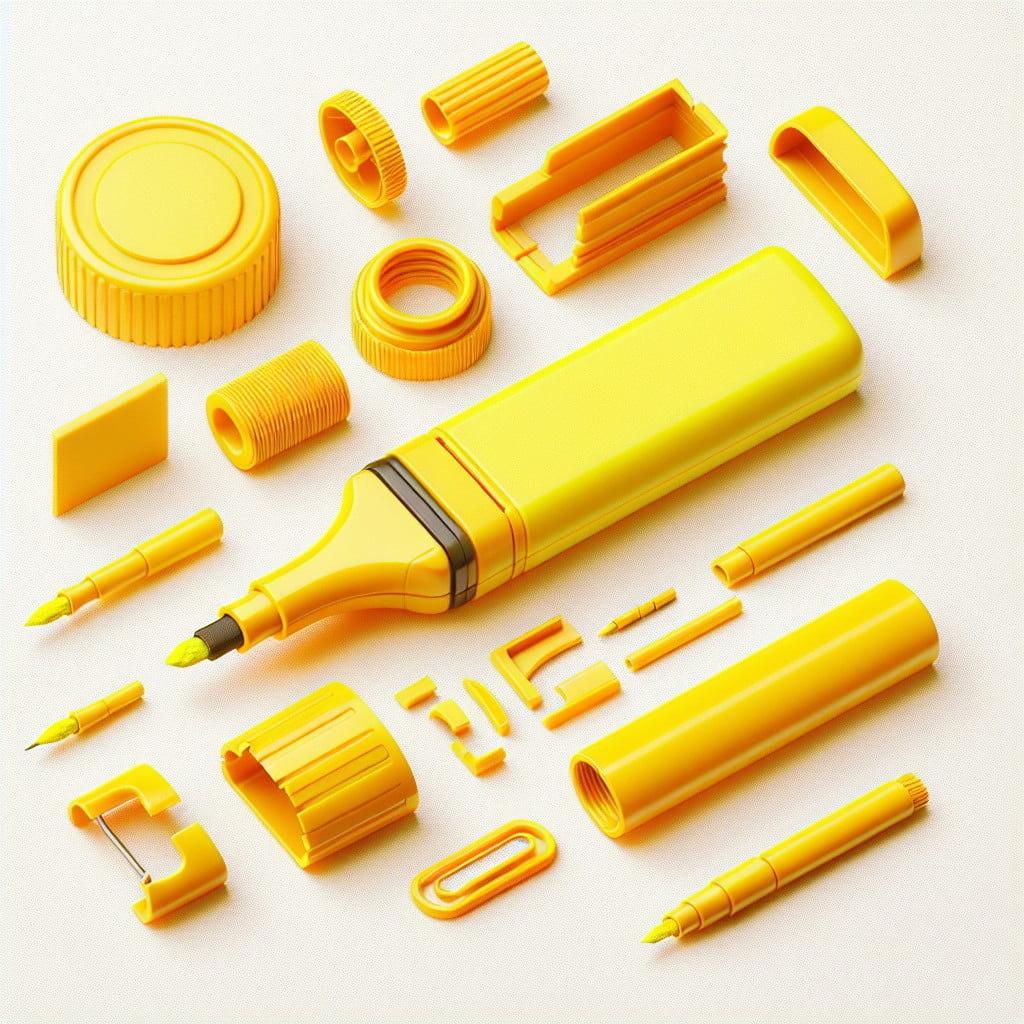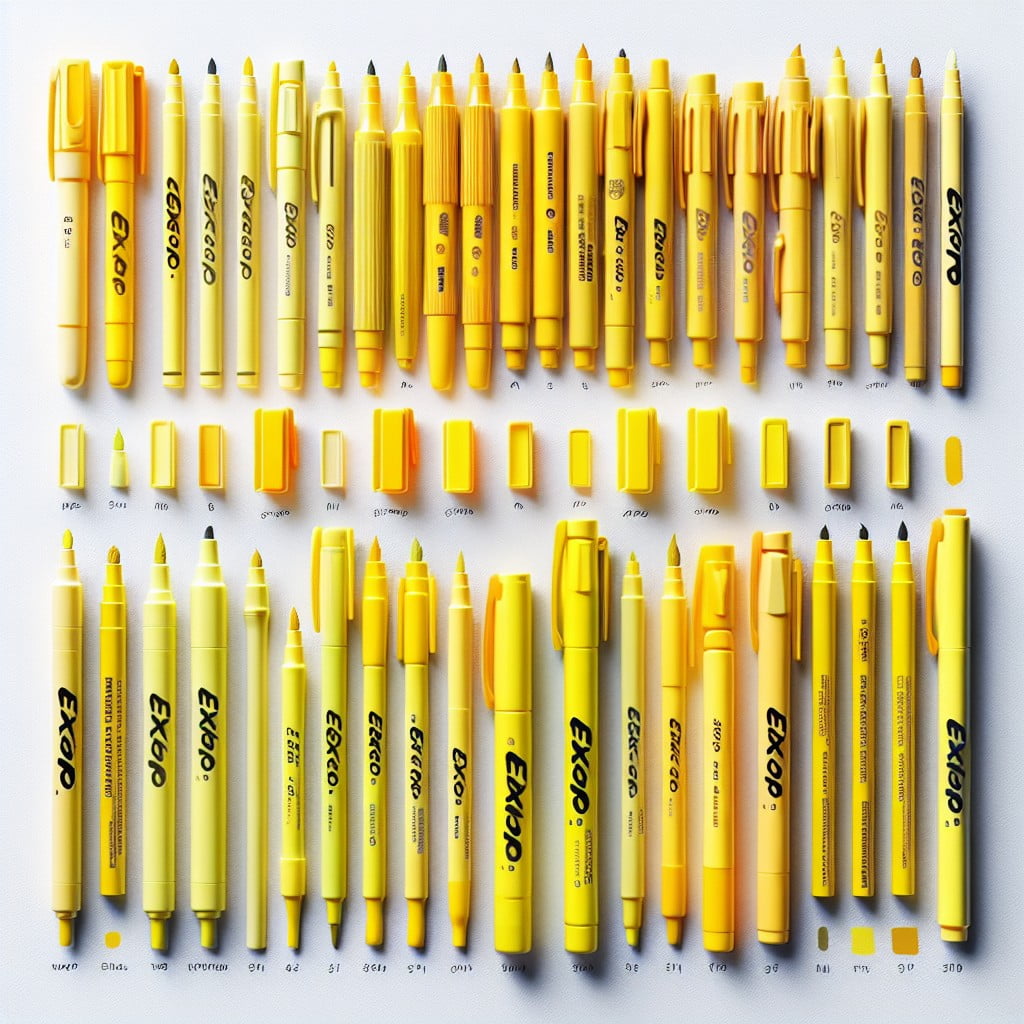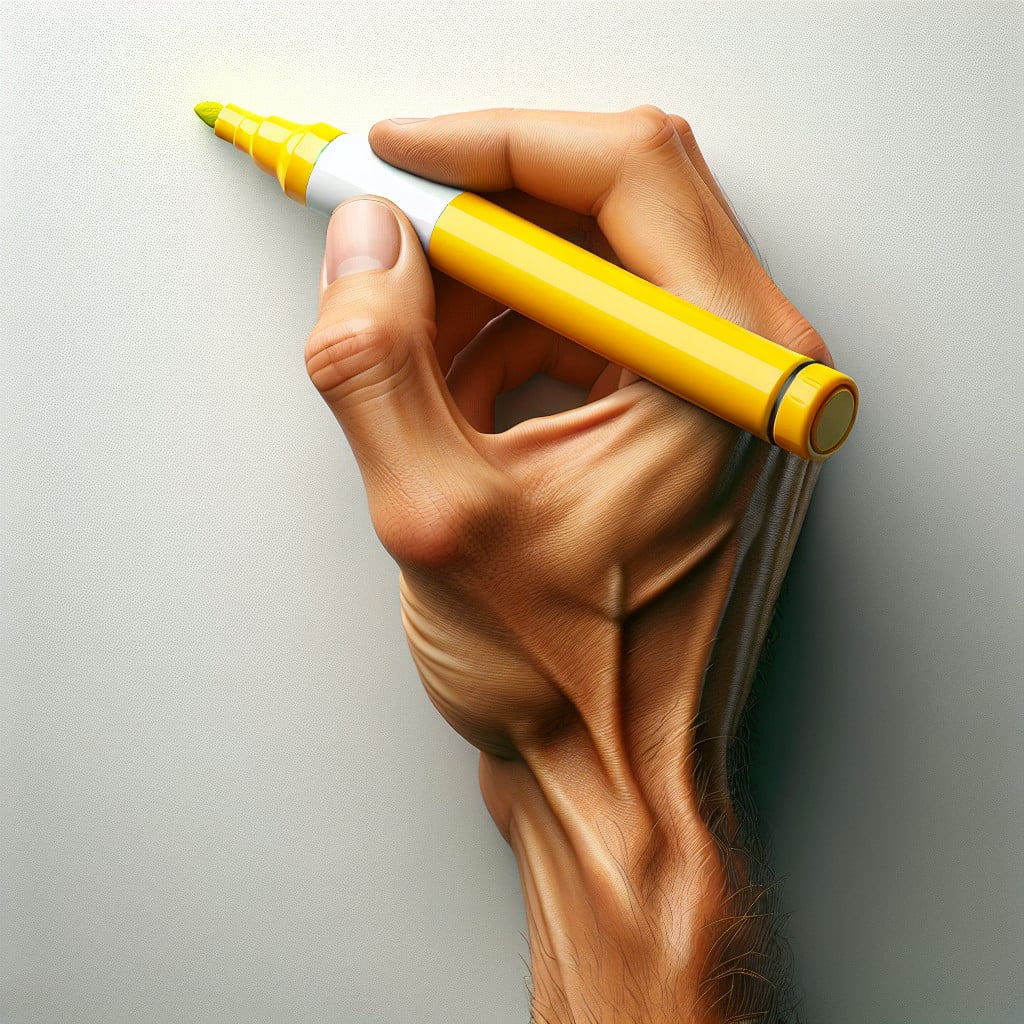Last updated on
Dive into the world of yellow Expo markers because their versatile nature can revolutionize your office or classroom experience, making brainstorming sessions more vibrant and organized.
Key takeaways:
- Yellow Expo markers contain color pigments, solvents, and release agents.
- Different types include bullet-tip, chisel tip, fine-tip, low-odor, washable, neon, and magnetic markers.
- Optimize performance by using a non-porous whiteboard, keeping the cap on, storing horizontally, writing with a gentle touch, and cleaning regularly.
- Store markers in a cool, dry place, position horizontally, and secure the cap.
- Common uses are highlighting key points, flagging ideas, organizing tasks, and facilitating workshops.
Composition of Yellow Expo Markers

Yellow Expo markers contain a mixture of color pigments, solvents, and release agents that work together to deliver their bright and easily erasable markings.
The pigments provide the distinct yellow hue, while solvents, typically alcohol-based, ensure a smooth flow and quick drying.
Release agents help you wipe away the ink from whiteboards without leaving stains.
Improved formulas have reduced the strong odor once associated with these markers, making them more pleasant to use in classrooms and meeting rooms.
It’s important to note that the ink formulation is non-toxic, ensuring safety during everyday use.
Different Types of Yellow Expo Markers

Expo offers a variety of yellow dry-erase markers suited for different preferences and uses.
Bullet-tip markers provide precision for writing and drawing, while chisel tips allow for both fine lines and broader strokes, making them versatile for teaching and presentations.
Fine-tip markers are ideal for smaller boards and detailed work.
In addition to tip variations, there are low-odor options for sensitive environments like small offices or classrooms, and washable versions designed for easy cleanup, which are especially useful in spaces frequented by children.
Neon yellow markers are available for use on black or dark surfaces, where they pop with fluorescent vibrancy.
Lastly, magnetic markers with built-in erasers add convenience by sticking to metal surfaces and enabling quick edits.
Tips for Using Yellow Expo Markers

To optimize the performance of your yellow Expo markers, adopt the following practices:
- Use a whiteboard with a non-porous surface to ensure that the marker ink can be easily erased and does not seep into the board.
- Keep the cap on when not in use to prevent the ink from drying out prematurely.
- Store your markers horizontally to maintain even ink flow to both tips.
- Begin writing with a gentle touch to avoid fraying the tip over time, which can lead to unclear lines.
- Clean the board regularly with a proper whiteboard cleaner to minimize ink residue, which can make new markings less vibrant.
- If the color begins to fade, prime the tip by pressing it down on a spare piece of paper until the ink flow returns to normal.
By following these guidelines, you will extend the life of your yellow Expo markers and ensure they consistently produce bright and clear markings.
How to Store Yellow Expo Markers

Ensuring the longevity of your markers hinges on proper storage. Keep them in a cool, dry place away from direct sunlight to prevent the ink from drying out prematurely.
Positioning matters – store them horizontally to maintain even ink distribution, which helps avoid pooling or drying at the tips.
If the marker comes with a cap, make certain it’s secured after each use to prevent air from sapping the moisture from the ink.
For educators and professionals who utilize these tools regularly, consider using a storage tray or a dedicated marker holder for easy accessibility and organization.
Remember, taking care of your markers means they’re always ready when inspiration strikes.
Common Uses for Yellow Expo Markers in Education and Professional Settings
In the classroom, these markers often brighten up whiteboard presentations, making key points stand out. Educators use them to highlight important information during lectures or to color code subjects for better visual learning.
In brainstorming sessions, yellow is excellent for flagging ideas that require caution or further thought.
Within office environments, professionals rely on them to draw attention to specific details on flip charts during meetings. They’re also instrumental in organizing tasks on whiteboards, where different colors represent priority levels.
Outside of typical presentation use, they are invaluable tools in facilitating workshops and training sessions where interactive participation is encouraged, and visual aids become a centerpiece for discussion.
The Lifespan of Yellow Expo Markers
The lifespan of these markers greatly depends on frequency of use, storage conditions, and whether the cap is secured properly after each use. Under normal circumstances, with daily use, a marker may last several weeks to a few months.
For optimal longevity:
- Always replace the cap tightly after use to prevent the ink from drying out.
- Store them horizontally to ensure the ink distribution remains even, preventing pooling at one end.
- Keep them at room temperature; extreme heat or cold can affect marker performance and lifespan.
- Avoid pressing too hard on the tip to maintain its shape and functionality, which can also prevent ink from running out prematurely.
By following these simple practices, you’ll maximize the life of your markers, ensuring they’re ready for use when you need them.
How to Revive Dried Out Yellow Expo Markers
When faced with a dried-out yellow Expo marker, don’t be too quick to throw it away. There are a few simple methods to breathe new life into it:
- Start by uncapping the marker and placing the nib (tip) facing down in a small container of rubbing alcohol for a brief soak. Five minutes is often enough for the alcohol to wick up into the felt and dissolve some of the dried ink.
- If rubbing alcohol isn’t available, try using the same method with warm water. It’s less effective but still worth the effort, especially for non-permanent markers.
- After soaking, replace the cap and allow the marker to sit tip-down for up to 24 hours. This helps the liquid to fully redistribute throughout the felt tip.
- For markers that are not too far gone, simply scribbling on a rough surface like sandpaper or a rubbery grip can sometimes remove the dried layer and get the ink flowing again.
- Remember that these methods have varying success rates and are best seen as a first-aid measure for markers. If reviving attempts fail repeatedly, it might be time to replace the marker to ensure the best performance in your tasks.
Comparison With Other Brands
When evaluating yellow Expo markers against competitors, consider the following aspects:
- Color Vibrancy: Compared to other brands, Expo often provides a bright, vivid yellow that stands out on whiteboards, making it ideal for high-visibility presentations.
- Ink Flow and Consistency: The flow of ink from an Expo marker tends to be smooth and even. Some other brands may have issues with ink flow, either releasing too much ink, which can cause smearing, or too little, leading to faint lines.
- Odor: Expo markers are known for their low-odor ink, which is especially advantageous in enclosed spaces or for individuals sensitive to strong smells. Some other brands may have a more pungent odor.
- Erasing: Expo markets its markers on the ease of erasability. Alternative brands might leave more residue or shadowing on whiteboards, requiring additional cleaning.
- Price Point: Price can vary significantly across brands. Expo markers tend to be in the mid to high range, reflecting their market positioning as premium products. Other brands may offer lower-priced options, but this can sometimes result in compromised quality.
- Tip Durability: The tips of Expo markers are designed for longevity, retaining their shape even after extended use. Some competing brands may show tip fraying or flattening over time, which affects precision.
- Availability: Expo’s wide availability makes them a convenient choice, as they can be found in most office supply stores and numerous online retailers. Niche or emerging brands may be harder to obtain.
Remember, the best choice of marker will depend on your specific needs and preferences, as well as the context in which the marker will be used.
Cleaning Tips for Yellow Expo Marker Stains
Removing yellow Expo marker stains can be a hassle, but with the right techniques, you can get your surfaces looking spotless again. For whiteboards, use a high-quality whiteboard eraser or a bit of rubbing alcohol on a soft cloth to gently wipe away any ghosting or residual marks.
If the stain is on fabric, place the item stain-side down on a paper towel and dab (don’t rub) the back of the stain with a cloth soaked in rubbing alcohol. Refresh the paper towels as needed, and launder the item according to the care label once the stain is lifted.
For hard surfaces like desks or walls, a mix of baking soda and water creates a gentle abrasive paste. Apply the paste with a soft cloth and rub lightly in a circular motion. Wipe clean with a damp cloth afterward.
Carpets and upholstery can be a bit trickier. Blot the stain with a solution of two parts water to one part vinegar, then a second clean cloth dipped in cold water. Press dry with paper towels, and vacuum once the area is completely dry to restore texture.
Remember, always test your cleaning solution on an inconspicuous area first to ensure it doesn’t cause damage or discoloration.
Recycling and Disposal of Yellow Expo Markers
Proper recycling and disposal are crucial for minimizing environmental impact. Most components of yellow Expo markers aren’t biodegradable and should not be thrown out with regular trash.
To recycle, check with local waste management for guidelines on plastics, as the outer casing is typically recyclable. For the ink cartridge and felt tip, specialized recycling programs like TerraCycle offer stationery recycling.
Schools and offices may collect spent markers for such programs. Alternatively, consider creative repurposing, such as using empty markers for art projects or storage for small items.
Always deplete markers fully to reduce waste, and when disposing of them, follow these steps to ensure they are handled responsibly.
FAQ
Does a yellow EXPO marker exist?
Yes, a yellow EXPO marker does exist.
What does EXPO mean marker?
EXPO marker refers to a type of dry erase marker that can be easily wiped off from surfaces such as whiteboards, glass, plastic, formica metal, and is available in a range of colors.
Why do EXPO markers erase Sharpie?
EXPO markers erase Sharpie due to their non-polar solvent that dissolves the bonds of the permanent marker, detaching it from the dry erase board’s surface.
How long do yellow EXPO markers typically last?
Yellow EXPO markers typically last up to a 2-3 year period with moderate usage.
Is there a way to refresh an EXPO marker once it starts to dry out?
Yes, by storing the EXPO marker tip-down and adding a few drops of isopropyl alcohol to it, one can refresh a dry EXPO marker.
Can you make temporary tattoos with yellow EXPO markers and how?
Yes, you can create temporary tattoos with yellow EXPO markers, by drawing your desired design on your skin and letting it dry.
Recap:




